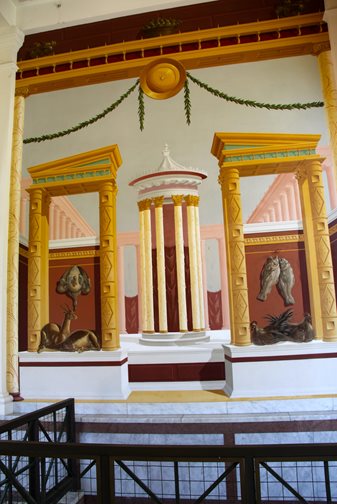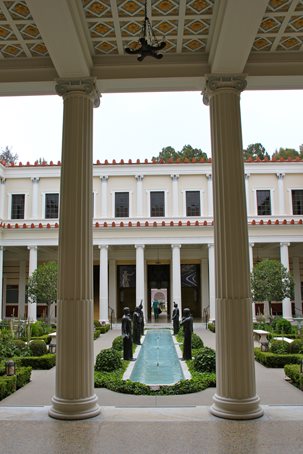Los Angeles: The Getty Villa
Posted on Aug 16, 2012 in category
The Getty Villa was built by John Paul Getty in 1974 to reproduce the ancient Roman Mediterranean 'Villa dei Papiri' or 'Villa of Papyrus' at Herculaneum near Pompeii. An architectural reconstruction that lasted 12 years and cost over $275 million, has enabled the Getty Villa to open 29 galleries to the public with over 14,630 square metres of exhibition space. It's truly "a place like no other" (John Paul Getty). Apart from the incredible attention to intellectual decorative detail (inspiration is also sought from sites in Pompeii, Oplontis and Boscoreale) that is sensitively coupled with modern architectural museum requirements such as staircases and a second storey, the Getty Villa's 26 hectares site boasts many other improvements. These improvements include four abundant gardens such as inner and outer peristyle gardens based on Roman research, a 450 seat Greek theatre, a 250 seat auditorium, the 'Ranch House' that is designed for a research library of 20,000 volumes and conservation labs/offices as well as a management facilities.
At the entrance gate we were escorted into a van and driven up the mock concrete 'Roman' cobblestone drive to the museum's entrance. A 'classic' underground carpark is cleverly positioned underneath the villa's Outer Peristyle Garden. Ingenious! Our early arrival at the Villa enabled us to enjoy the 'Herb Garden' and the Outer Peristyle pool and garden before many visitors arrived.

'Drunken Satyr with a Wineskin', a bronze reproduction from the 'Villa dei Papiri', Herculaneum. A satyr was a follower of the god of revelry and wine, Bacchus. The pool's function is debatable but it's suggested that the Romans combined a swimming pool with a fishpond.

Looking south from the museum towards the far end of the 'Outer Peristyle Garden'.
Wall paintings in the Peristyle Garden depict garlands with theatrical masks strung between columns. Birds, lizards and insects add to this festive scene which was borrowed from the villa at Boscoreale believed to have belonged to Publius Fannius Synistor. Several genuine Boscoreale wall paintings are now displayed in the Metropolitan Museum of Art in New York (see my blog entry, which will follow later, on this superb New York museum).

The wall painting on the 'North Wall' of the Outer Peristyle was inspired by the Imperial Villa at Oplontis (built in 50 B.C. and whose owner was Nero's second wife, Poppaea Sabina) as well as the 'Villa dei Papiri', Herculaneum. For a good article on recent digital work on Oplontis see: port.academia.edu/DavidAnderson/Books/1579987/The_Preservation_of_Complex_Objects_Volume_1_Visualisations_and_Simulations

Both the Outer and Inner Peristyle Gardens are adorned with copies of the original bronzes found in various locations in the 'Villa dei Papiri'. Some 99 statues of marble (22 in number) and bronze have been excavated from the Herculaneum site whose archaeological history goes back to the 18th. century under Bourbon King Charles III (A.D.1738 official excavations began although the first statuary was found from a well construction in A.D.1711). Crude tunnelling excavation techniques by Spaniard surveyor Alcubierre were somewhat improved by Swiss engineer Karl Weber who published a plan of the 'Villa dei Papiri' on July 20, 1754 A.D. The 'Villa dei Papiri' gets its name from 1,800 rolls of papyrus discovered in a room or library. Written largely in Greek ( a few Latin texts were found), the rolls of papyrus are mainly the words of Philodemus of Gadara, a philosopher of the 1st. century B.C. The owner of the villa is believed to be Julius Caesar's father-in-law, Lucius Calpurnius Piso Cesoninius, who was consul in 58 B.C. and a follower of the Epicurean school of philosophy. He was a great collector and patron of bronze and marble sculptures as evidenced from his legacy in Rome's Saepta building (see: Saepta Iulia in Rome)

A view of the Inner Peristyle fountain with five bronze statues depicting the Danaids or water-carriers. Legend tells us that King Danaus of Argos ordered his 50 daughters to kill their promised Egyptian husbands on their first wedding night. One daughter defied her father's order and she was rewarded by her grateful father-in-law pharaoh by not sharing her sisters' agonising fate, eternal water haulage.

'Bust of a Man Wearing a Turban' - a reminder of the reach of the Roman empire?
Carol Mattusch (2005) classifies four categories of bronze and marble statuary found in the 'Villa dei Papiri': small portraits of writers, herms of famous men, large copies or copy-like statuary from Baiae or from a similar site and fountain decoration. Gods are rarely depicted but followers of Bacchus were popular.

A Silenus bronze features here in the Herb Garden's main fountain. A tutor of Bacchus, Silenus was said to be prophetic when intoxicated. King Midas treated Silanus kindly and Bacchus rewarded King Midas with his main wish - to turn everything he touched to gold. According to C. Mattusch (2005) the original bronzes at Herculaneum's 'Villa dei Papiri' were collected over time as purchases, gifts or exchanges not as one big purchase from one vender. Ironically, this is unlike the many bronze reproductions at the Getty Villa which were purchased from the Chiurazzi family's foundry in Naples.
Over 1,200 works of art are displayed within two storeys with galleries organised by themes such as a 'TimeScape Room' with Greek, Etruscan and Roman exhibits, a 'Temple to Herakles', 'Luxury Vessels', 'Glass' and 'Religious Offerings' to name only a few.

Two bronze wine storage jars from Campania 1-79 A.D. displayed in the 'Bronze Vessels' gallery.

A Gallo-Roman statue of Mercury, god of commerce and travel, holding a money bag dated A.D.100-120 (provenance is unknown). Mercury was syncretised with the indigenous deity Lugus, who was one of the most popular gods in Gaul. Mercury was also known as the inventor of the arts.
The question of provenance and ownership of works of art has recently plagued the Getty Villa Museum. The Italian government in 2005 charged some of the museum's staff with stealing antiquities demanding that 52 items be returned. Former Australian Director Michael Brand had the difficult job of negotiating with the Italian government (40 items were eventually returned to Italy!) and confronting the 25% drop in budget income to the museum as a consequence of the 'Global Financial Crisis'. Read the interview with Michael Brand.

A 'Basilica' or large public greeting hall is included in the Villa's design. Decorative motifs include acanthus scrolls on the barrel vault's ceiling frieze borrowed from the ceiling of Pompeii's Forum Baths, the half-dome decoration from the 'House of Menander' in Pompeii, the ceiling's coffered panels from the 'House of the Cryptoporticus' in Pompeii, marble capitals copied from Herculaneum's 'House of the Deer' and an elaborate multi-marble floor from the 'Villa dei Papiri' itself. The pièce de résistance of the Basilica is 'Youth as a Lamp Bearer'. The bronze statue was excavated in 1925 from the 'House of the Ephebe' in Pompeii believed to have possibly belonged to Publius Cornelius Tegete.

'Youth as a Lamp Bearer' holds the candelabra in his left hand.

Another Pompeiian artefact is this silver and gold bull believed to be once a permanent fixture in a household's lararium or shrine which was probably dedicated to Jupiter.
The 'Inner Courtyard' is also a potpourri of artistic influences in helping visitors feel what it was like to be a Roman living in the 1st century A.D. The columns used were modelled on the 'House of the Coloured Capitals' in Pompeii, the walls were influenced by the 'First Pompeiian' or monumental style from the 'House of the Faun' in Pompeii with simple mock marble blocks encrusted on them, the ceiling coffers were inspired by a tomb decoration in the' Street of the Tombs' in Pompeii and the small square marble fountain was recorded in an 18th century drawing from the 'Villa dei Papiri'.

One of John Paul Getty's favourite works of art was the 'Landsdowne Herakles' named after the Marquess of Landsdowne who purchased the statue in A.D.1792. The statue was excavated near Hadrian's Villa at Tivoli, Italy. An 18th century restorer added a few creative additions.

The spectacular mosaic floor is a replica from the 'Villa dei Papiri' with over 4,000 pieces of marble imported from Turkey, Tunisia, Egypt, Greece (2 types of marble) and Italy. Coloured marble mosaics collected from all over the empire were the most expensive and prestigious floor decorations in ancient Rome times.
The Getty Villa is far from being a folly or a parody of history. It's a joy to visit, an artefact among many artefacts. It's far more interesting than Disneyland although it does share a little fantasy with its more popular Los Angeles tourist destination. Check out this map and guide to the Getty Villa before you visit:
Map and Guide to the Getty Villa

This Roman glass with a Greek inscription epitomises the Getty Villa Museum:
"Rejoice and be Glad" (A.D. 1-100). Many thanks to Paul Moniodis for this translation.